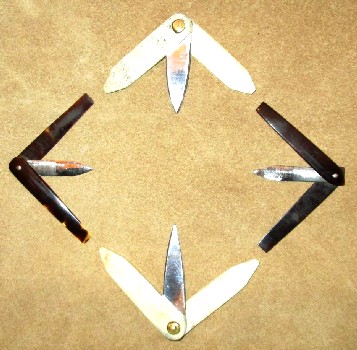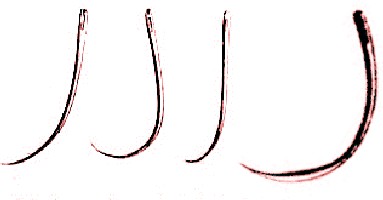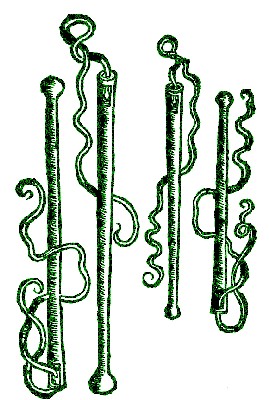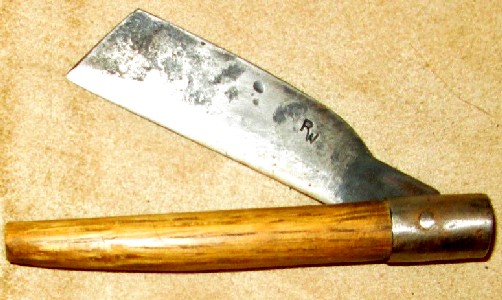
Portable Surgical Kits Page Menu: 1 2 3 4 5 6 7 8 9 Next>>
Portable Surgical Kits From the Golden Age of Piracy, Page 3
Plaster Box and Pocket Kit Instruments - Plaster Box and Pocket Kit Continued
8. Incision Knife (Scalpel)
Included by: Charles Gabriel Le Clerc & Thomas Brugis
The incision knife is not typically referred to as a scalpel in the texts from this time. 
Incision
Knives,
From A
General
System
of
Surgery,
By Lorenz
Heister (1750) If the term 'scalpel' was used, it was mentioned after 'incision knife'. Randle Holme explained that "the Latin name it Scapellum", which explains the source of that term, although he does not actually refer to it as a scalpel in this explanation of its use.1 Holme goes on to explain that an incision knife "is a small Pen knife with a bending point, and some are straight pointed, slender, and narrow bladed"2. The thin bladed scalpels would eventually acquire the name bistoury in the late 18th century, borrowing from the 15th century Old French term bistourie (dagger).3 However, just as the standard bladed incision knife was not called a scalpel, these were not yet called bistoury knives.
Lorenz Heister lists two incision knives to be included in his pocket kit: "a strait Incision-Knife... [and] a strait double-edged Incision-Knife"4. French surgical instructor Pierre Dionis highlighted another characteristic of incision knives, noting that some of them "may be folded backwards and forwards"5. A folding incision knife could be carried loose in the surgeon's pocket if necessary, although they typically are mentioned as being kept in a pocket kit or plaster box.
Thomas Brugis ordered: "Let this Instrument be always kept clean and bright, by being rubb’d dry after it hath been used, and sharp as any Razor."6 This suggests that the incision knife would be made out of the same fine steel as a razor. Sea surgeon John Woodall similarly advises the surgeon's mate (assistant) to "keepe them sharpe and cleane; 
Folding & Fixed Incision
Knife,
From Armamentarium
chirurgiae Appendix, By
Johannes Scultetus (1671) but let them not be so thinne grownde in the edge as the Rasor, for then they will deceive the workeman, when hee hath most use of them"7.
There was surprisingly little support for the inclusion of a straight scalpel or incision knife in the surgeon's portable instrument sets, being included by only two of the eight authors. Sea surgeon John Woodall explains that while there were many potential uses for incision knives, its use in practise should be limited. "I advise the Surgions Mate not to be too forward, nor too rash, but to take good advise, namely, if the Patient may by any better way else receive health, that he forbeare incision, if not, let him proceed in the name of God."8
Warnings by Woodall aside, a couple different uses were noted by period authors who commented on them, including Woodall himself. Among the many uses were "paring away the putrid part of a Gangrenous Member"9, to open "small Apostemes in the mouth, throat and gummes"10, for incisions to be "made in the Head"11, to open (dilate) narrow wounds12 and to scarify body parts (make multiple small incisions to bleed a patient) or create fontanels.13 Basically, as Thomas Brugis notes, the incision knife is used when the surgeon must "cut the Skin or Flesh upon needful occasions"14.
Both Woodall and Brugis warn about having an incision knife visible when operating on a patient. Woodall says that it "is commendable in an Artist to bee very carefull to hid his sharpe instruments ever as much as is possible from the sight of the Patient, for many reasons too long to recite."15 Brugis recommends that "the Artist ever hide it from the Patient’s sight with a Cloth" along with any other sharp instruments.16
Ever the teacher, Dionis provides a thumbnail sketch of the use of an incision knife. "Every Body knows in the Use of these Instruments, that by the Fingers of the Right Hand they must be held by the Blades which turn on their Handles, which serve as a Counterpoise to the Hand during its Operation, and as Sheaths to the Blades at other Times."17
1,2 Randle Holme, The academy of armory, 1688, p. 426; 3 Collins English Dictionary – Complete and Unabridged, 12th Edition, 2014; 4 Lorenz Heister, A General System of Surgery in Three Parts, 1750, p. 12; 5 Pierre Dionis, A course of chirurgical operations: demonstrated in the royal garden at Paris. 2nd ed., 1733, p. 14; 6 Thomas Brugis, Vade Mecum, 1689, p. 3; 7,8 John Woodall, the surgions mate, 1617, p. 1; 9 Brugis, p. 3, See also Woodall, p. 1 & Holmes, p. 426; 10 Woodall, p. 2; 11 Dionis, p. 14-5; 12 Holmes, p. 426; 13,14 Brugis, p. 3; 15 Woodall, p. 2; 16 Brugis, p. 3; 17 Dionis, p. 15
9. Lancet
Included by: Charles Gabriel Le Clerc, Peter Lowe, John Woodall & Randle Holme
Lancets had wide support from the period authors. When describing them, sea surgeon John Woodall said "without question each Surgeons Mate [assistant] knoweth a Lancet as well as my selfe"1. Lancets had sharp points on the end and were usually found with two rotating handles on either side of the blade. Randle Holme explains that lancets are "sharp in both edges; fixt in a Tortoice case, or such like [referring to the handles], to preserve it point, 
Photo: Mission
Lancets of Different Shape, Size and Length. The
Handles of the Top
and
Bottom Are
Bone While The Left and Right are Tortoise Shell and keep it cleane."2 Woodall recommends that "Lancets be not too spere [spear] pointed, I meane small pointed, for the broadest pointed Lancets make the best work."3 Although most of the period authors don't mention it, lancets were often of slightly different shapes, sizes and lengths.
Woodall says that the surgeon's mate should "cary with him at the least sixe of the best sort, besides sixe more common ones, for an East Indie voyage: that he oile them, or anoint them with Axungie [lard, probably pork], and so wrappe them in oyly cloutes, that they rust not."4 This is the kind of care lavished on expensive instruments such as razors. The difference between the 'best' and the 'common' lancets probably had to do with the type of steel they were made from and how well they could maintain an edge. Holme says that a lancet is a "slender blade made of Razor mettle"5 referring to the more expensive low-carbon steel made by cementation which was used during this time. Like some of the other authors, he mentions the need to protect the blade and keep it clean as quoted previously. Woodall further orders the surgeon's mate that he only remove the lancet from it's oiled cloth when he is ready to use it6, most likely to protect the tip from breaking and the blade from corroding in the salty sea air.
Lancets basically had three uses according to the period authors. 
Folding Lancets, From A
General System
of
Surgery, By Lorenz Heister (1750) These were "to make an Orifice in a Vein for blood letting ...and [to] open Impostumations [abscesses] in the Skin, and [make] other incisions more in the flesh as need requireth."7 With regard to incisions, physician Helkiah Crooke says that they "may be of use in tender and soft parts"8. In his book, surgeon Lorenz Heister figures "two Lancets of different sizes: These are used, especially the smaller sort, in opening Veins... but the larger sort are used to open Abscesses with"9. He does not mention them being used to make incisions. (See the image at right.)
1 John Woodall, the surgions mate, 1617, p. 28; 2 Randle Holme, The academy of armory, 1688, p. 428; 3,4 Woodall, p. 28; 5 Holme, p. 428; 6 Woodall, p. 28; 7 Holme, p. 428; 8 Helkiah Crooke, An Explanation of the Fashion and Use of Three and fifty Instruments of Chirurgery, 1634, p. 4; 9 Lorenz Heister, A General System of Surgery in Three Parts, 1750, p. 11
10. Needles
Included by: Charles Gabriel Le Clerc, William Fabry, Peter Lowe, John Woodall, James Cooke, Thomas Brugis & Randle Holme
Needles were usually included in portable surgical kits, housed in the stitching quill or cannula. Sea surgeon 
Suture Needles, From A General System of
Surgery, By Lorenz Heister (1750) John Woodall says that "stitching needles have their due place in the plaster box"1. Fellow English surgeon Thomas Brugis says they "are Instruments that cannot be missed in your Plaster-box"2. Several other surgeons mention their presence in pocket kits and plaster boxes without giving much detail about the needles themselves. German surgeon William Fabry advises the surgeon to include in his pocket kit "Needles, to stitch up great Wounds, which are to be of different Sizes, some great, others small, &c."3 English surgeon Lorenz Heister only says the surgeon's pocket kit must have "different sorts of Needles, strait and crooked"4, but he does include an image of the curved needles to help clarify them.
Some surgeons give more precise information about the needles to be included in portable kits. Brugis orders his readers to "have in your Stitching Quill at least three Needles of several sizes or bigness, with square points, well set"5. Woodall agrees with him (possibly because Brugis appears to have borrowed heavily from Woodall, restating his points in slightly clearer fashion).6

Suturing needle for amputation, From The chirurgeon's storehouss,
By from Johannes Scultetus' (1674)
James Cooke recommends that the suturing "needles are to be either flat-pointed, or square, they need to be six in number, of several sizes". In addition there should be "3. Needles, ordinary ones, [which] you had need have also to make rowlers [roller bandages]"7. Brugis and Woodall likewise mention that the surgeon should have such needles prepared.8 French surgeon Charles Gabriel Le Clerc doesn't give a lot of detail on most of the needles, however he does state that surgeons "likewise carry… a Carlet, or thick triangular Needle"9. Such a needle was used to suture the end of a patient's stump after amputation.
For the portable kits, Woodall advises the surgeon to "forget not to have at the least three ready needles well armed …I meane threded with strong coulored silke"10. He adds that a "double colored silke is the best to stitch with"11 without explaining why this is so. Brugis advises they be "ready armed with green or red Silk"12. He adds that "in want of Silk, at any time upon necessity, you may use thread"13. Woodall suggests likewise.14 Cooke simply notes that the surgeon should use strong silk15 without mentioning color.

Threaded Straight and Curved Suture Needles, From The Workes of that Famous
Chirurgion Ambrose
Parey, By Ambroise Paré, p. 256 (1649) Everyone who discusses the suturing materials notes that they should be coated with something. Brugis suggests the silk should be oiled and the thread be rubbed "with some kind of Emplaster"16. Woodall says, "It is... convenient to waxe the thred or silke, or to use some emplaster to rubbe it with in place of waxe."17 Cooke recommends that silk suture be "waxed, and anointed with some balsome"18. Brugis also recommends that the "Needles always kept oiled, and clean from rust"19 while Woodall recommends they be waxed.20
The general use of suture needles is fairly straightforward: they are to suture the skin when such is necessary. A detailed exploration of this use can be found in the article on suturing. In addition to 'stitching' Heister also mentions that they are useful for "taking up of Arteries, and many other Uses"21.
1 John Woodall, the surgions mate, 1617, p. 27; 2 Thomas Brugis, Vade Mecum, 1689, p. 5; 3 Guliielm. Fabritius Hildanus aka. William Fabry. Cista Militaris, Or, A Military Chest, Furnished Either for Sea or Land, 1676, p. 22; 4 Lorenz Heister, A General System of Surgery in Three Parts, 1750, p. 12; 4 Brugis, p. 5; 6 Woodall, p. 27; 7 James Cooke, Supplementum chirurgiae and the Military Chest, 1655, p. 420; 8 Brugis, p. 6 & Woodall, p. 27; 8 Woodall, p. 27; 9 Charles Gabriel Le Clerc, The Compleat Surgeon, 1701, p. 5; 10,11 Woodall, p. 27; 12,13 Brugis, p. 6; 14 Woodall, p. 27; 15 Cooke, p. 420; 16 Brugis, p. 6; 17 Woodall, p. 27; 18 Cooke, p. 420; 19 Brugis, p. 6; 20 Woodall, p. 27; 21 Heister, p. 12
11. Probe
Included by: Charles Gabriel Le Clerc, William Fabry, Peter Lowe, John Woodall, James Cooke, Thomas Brugis & Randle Holme
The humble probe was considered an essential instrument in a portable medicine kit. It is mentioned by almost every author. English surgeon Thomas Brugis declares,

Probe,
Heister
(1750)
"The Probe cannot be missing in the Chirurgions Plaster-Box, for without it can nothing be done artificially [as opposed to things healed by nature]."1 Sea surgeon John Woodall said of probes, "no chirurgical worke is well and artificially effected without some occasion of the use thereof more or lesse"2, reiterating this point when discussing plaster box instruments, where "the small Probe... is a very necessary instrument which cannot well bee missed."3
The basic probe was a metal rod. There were a variety of types, the configuration of the end being the differentiating factor. Some came with a needle-like eye at one end. Surgeon James Cooke explains that "The Probe is to have an eye, by which flammula’s [a thin piece of soft cloth] may be drawn through a wound"4. Helkiah Crooke describes a probe that has a round, smooth end with the other having "a needles eye, that if the wound bee through and through, they [the surgeon] may draw a seton [piece of thread or string] or flamula through it"5. Randle Holme likewise mentions a "Streight Probe with a needle Eye" which he said was "much used"6.
Lorenz Heister describes another type of probe, "one End of which is broad and thin... [and] the other End is rounded"7. (See image at right.) Helkiah Crooke mentions another type of probe which is "round and smooth, with a smooth button at the end"8. French surgeon Charles Gabriel Le Clerc details several types of probes a surgeon should have including a hollow probe, "as also many other Probes, streight, crooked, folding, and of different thickness[es]"9. Holme discusses "the Crooked Probe, or Spatula Probe, being broadish at one end whose use is for the Searching of wounds; and the other end to put powders on wounds, and anoint Plagets [pledgits] with ointments."10 Thomas Brugis details a screw probe, which he explains "Is as long as an ordinary Probe, made to unscrue in the middle, and is used where the small Probe is too short to make sufficient probation."11 It is likely that the probe had to come in two parts so that it would fit in his plaster box with the 'small Probe'.
With regard to material, Lorenz Heister says, "The neatest Probes are made of Silver, though

Eyed
Probe,
Cooke
(1685)
they are frequently also made of Steel, Ivory, or Whalebone."12 While explaining his hollow probe, Le Clerc explains that it is "made of Silver or fine Steel"13. Randle Holmes says probes are used for examining wounds are "for the most part of Silver or Ivory"14.
As their name suggests, one purpose of a probe was to examine wounds. This was particularly important to surgeons as it was one of the few ways for them 'examine' a wound without enlarging it. (X-rays were yet hundreds of years in the future.) Woodall explains that they were "sometimes [used] to inquire the depth of a wound, ulcer, or fistula", simultaneously warning against "forcing to[o] farre the Probe, thereby to make the greife appeare deeper, which I advise young Surgeons to make a conscience of, for by such abuse the Patient is many times greatly indangered of his life."15 English surgeons Lorenz Heister and James Cooke both echo this.16 Heister explains that the rounded end of a probe is best used for this purpose.17 Helkiah Crooke indicates the same thing, adding that there should be "a smooth button at the end... for being smooth and buttoned, it will not violate the flesh in the search."18 Randle Holme is more specific, noting that this probe is used "to search where those strange substances lye in the wound (for the lippes of the wound presently upon the stroake will close together)". He later suggests that it can also be used "to draw the Stone out of the Yard [penis] &c."19
Woodall explains that probes were also to be "armed with drie lint and dipped into some lotion, oyle or liquor, therewith to mundifie [cleanse] corrode or heale the greife according to the due occasion thereof"20. He elsewhere adds this is done "to clense wounds, ulcers, fistulaes &c."21 Brugis agrees with Woodall, noting that this is performed when "the small end armed with Lint"22. Holme explains how this done: "it hath dry Lint wrapped about the button end, which keeps it from sliping off, which is by the Artist termed, Armed with dry Lint, or Arm the Probe, by which the wound is mundified and cleansed from matter and filth." Holme also explains that once the probe has been "dipt in some Lotion, oyle or other Liquor; doth Bath[e] or Drench, Corrode or Supple a wound, to heale and asswage it paine."23

Threaded, Eyed Probes, From
An Explanation of
Three and fifty Instruments, By Helkiah Crooke,
p. 33 (1634)
If the probe had an eye, it could be used to create a fontanel. James Cooke says, "The Probe is to have an eye, by which flammula’s [soft pieces of cloth] may be drawn through a wound, especially near great joints, as shoulder, &c. especially if the body be infected with lue vener. [syphilis]."24 He goes to mention a case where a man had been 'run through the shoulder' with some sort of blade, "through which I drew a flamula, and there kept on till he was rid of a bad companion, and then drawing it forth, speedily cured the wound."25 In this way, the probe serve the function of a seton needle, with the cloth being left behind to antagonize the wound and cause it to suppurate or form pus and eject unwanted humors. In fact, Helkiah Crooke refers to the piece of cloth as being "a seton or flamula... [by] which they [surgeons] anoint with medicines fit for their purpose"26.
Crooke also gives a detailed description of how a probe can be used when dealing with a bullet that has gone deep into the body without going through it. In such a case,
the bullet cannot be drawne out where it went in, then the button of the needle serves to discover what distance there is of flesh between the bottome of the wound and the contrary side; and if it bee not much, they make incision, and so take out the bullet; and when that is done; they draw a seton or flamula through to facilitate the cure. So that this Instrument serves for a double, yea a trible use, and therefore you have the description of it here expressed.27
1 Thomas Brugis, Vade Mecum, 1689, p. 4; 2 John Woodall, the surgions mate, 1617, p. 12; 3 Woodall, p. 27; 4 James Cooke, Supplementum chirurgiae and the Military Chest, 1655, p. 421; 5 Helkiah Crooke, An Explanation of the Fashion and Use of Three and fifty Instruments of Chirurgery, 1634, p. 82; 6 Randle Holme, The academy of armory, 1688, p. 434; 7 Lorenz Heister, A General System of Surgery in Three Parts, 1750, p. 12; 8 Helkiah Crooke, An Explanation of the Fashion and Use of Three and fifty Instruments of Chirurgery, 1634, p. 82; 9 Charles Gabriel Le Clerc, The Compleat Surgeon, 1701, p. 5; 10 Holme, p. 434; 11 Brugis, p. 4-5; 12 Heister, p. 12; 13 Le Clerc, p. 5; 14 Holme, p. 434; 15 Woodall, p. 12; 16 Cooke, p. 422 & Heister, p. 12; 17 Heister, p. 12; 18 Crooke, p. 82; 19 Holme, p. 434; 20 Woodall, p. 12; 21 Woodall, p. 26, See also Cooke, p. 421; 22 Brugis, p. 4; 23 Holme, p. 434; 24 Cooke, p. 422; 25 Cooke, p. 422; 26,27 Crooke, p. 82
12. Razor
Included by: Charles Gabriel Le Clerc, Peter Lowe, Felix Würtz & James Cooke
Razors were only included by half of the eight surgeons who discussed portable instrument kits. 
Folding Razor, From Mellificium chirurgiae, By James Cooke
p. 13,
(1685) This is not to say that the surgeon wouldn't have one, just that it wasn't included with the portable instruments. For example, sea surgeon John Woodall describes having four of them in the barbering kit he prepared for the East India company.1 It is also possible that it wasn't included because many of its surgical functions were overlapped by other tools which were included in portable kits.
The design of razors from this period were a little more primitive than even the straight razors of the nineteenth and twentieth centuries, often not having many of the safety features which modern versions included. The full explanation of the differences can be found on this page of the barbering article. Not much is said in the period books about the razor itself, likely because it was familiar to most surgeons. Randle Holme describes the razor as being "very sharp in the edge, with a broad and thick back, by which meanes it is fastned in a bone, horn or tortice shell hast [handle], like a foulding knife."2

Photo: Mission - Reproduction Folding Razor From the Author's Collection In terms of care of the instrument, surgeon James Cooke ordered that the razor was "alwayes to be kept sharp and free from rust"3.
The most obvious use of the razor was for shaving, which Holme said was 'the Barbers office.' It had added use for the surgeon in this capacity, however. "Its very useful in wounds of the head and hairy parts, to remove the haire, otherwise medicaments will not stick long, neither can they be kept clean about the wound"4. Holme agreed, but added that "the Surgion [also] useth it very often about his imploy, especially when there is no feare of hurting the parts under the place where Incisions and Scarifications are to be made, or such like operations wrought."5
1 John Woodall, the surgions mate, 1639, not paginated; 2 Randle Holme, The academy of armory, 1688, p. 434; 3,4 James Cooke, Supplementum chirurgiae and the Military Chest, 1655, p. 418; 5 Holme, p. 429

